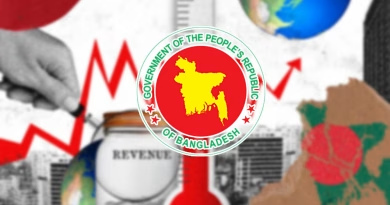Foreign exchange reserve is a strong indicator of an economy. It is believed that rising reserves signify the economy is in a comfortable position. When reserves dwindle, the potential for an economic crisis emerges.
Declining reserves cause development partners and lending institutions to lose confidence on economy. In respect of obtaining foreign aid, it becomes tough task. For an import-dependent economy like Bangladesh, maintaining significant foreign exchange reserves is paramount.
Bangladesh receives minimal foreign direct investment. Consequently, reserves must be increased through export earnings and remittances from expatriates. Extremely positive news is that export growth reached 10 percent and remittance growth reached 27 percent in the 2024-25 fiscal year. This suggests a favorable wind has begun to blow for Bangladesh’s economy.
For the broader interests of the economy, export earnings naturally follow remittances in attracting attention. Regrettably, due to the Trump administration’s countervailing tariff policy, Bangladesh’s export sector is heading towards a crisis in the coming days. This will impact the overall economy.
Since the United States is Bangladesh’s single largest export market. Seventeen percent of Bangladesh’s total exports go to the United States. The majority of this is ready-made garments. The ready-made garment sector accounts for 85 percent of total exports.
The top seven countries in apparel exports are: China (share 29.64 percent), Bangladesh (6.90 percent), Vietnam (share 6.09 percent), Turkey (share 3.21 percent), India (share 2.94 percent), Cambodia (share 1.77 percent), Pakistan (share 1.66 percent). This is according to the World Trade Organization’s “World Trade Statistical Review 2024”.
Bangladesh has maintained its second position in apparel exports through various strategies. Notably, although Bangladesh is second, its apparel export growth is much lower than competitor countries.
According to WTO data, ready-made garment export growth in 2024 was: China 30 percent, Vietnam 9.34 percent, India 6.5 percent, Cambodia 24.19 percent, Pakistan 21.44 percent, Indonesia 4.67 percent. Regrettably, Bangladesh, positioned second, recorded growth of only 0.21 percent – the lowest.
Already, the United States has imposed an additional 35 percent countervailing duty on top of the existing 15 percent duty on Bangladesh. Meaning, from August, Bangladesh will have to pay 50 percent duty to enter goods into the US market. Whereas for Vietnam, one of Bangladesh’s key competitors in the apparel sector, the countervailing duty has been set at 20 percent. Initially, it was imposed at 46 percent. Vietnam succeeded in negotiations, but Bangladesh failed.
It should be noted that Vietnam sends 30 percent of its total exports to the United States. Due to the Trump administration imposing countervailing duties in April, Bangladesh withdrew tariffs on 110 US products in the 2025-26 fiscal year budget.
Trump stated in his latest letter that Bangladesh’s tariff and non-tariff barriers have caused a trade deficit with the United States. According to the Office of the United States Trade Representative (USTR), bilateral trade between the two countries was recorded at $10.6 billion in 2024.
Of this, Bangladesh exported $8.4 billion to the US. Meaning, the trade deficit is substantial. The question is, can this trade deficit be eliminated overnight?
Trump said the trade deficit is a major threat to the economy and national security. Notably, the US effective tariff rate is now 15 percent.
Over the past 40 years, it ranged between 2 and 4 percent. The author believes geopolitics is a key reason behind Trump’s imposition of countervailing duties. Bangladesh has also fallen victim to geopolitics for various reasons.
Several years ago, Bangladesh sought membership in the BRICS bloc. BRICS members are: Brazil, Russia, India, China, South Africa. Subsequently, Egypt, Ethiopia, Indonesia, Iran, Saudi Arabia, and the United Arab Emirates joined, making it BRICS Plus. China essentially leads this bloc. Vietnam is always China-dependent.
The US once urged Vietnam to reduce its dependence on China. When BRICS members criticized US tariff policy, Trump imposed a 145 percent tariff on China. In retaliation, China imposed a 125 percent import duty on the US.
Very recently, the US, for its economic interests, finalized a rare minerals-related agreement with China. The BRICS bloc wanted to conduct trade in their own currencies, excluding the US dollar.
In 2024, Trump threatened that if BRICS countries moved towards introducing their own currency as an alternative to the US dollar, a 100 percent tariff would be imposed on them. Furthermore, over the past decade, bilateral relations between China and Bangladesh have reached a high level. Talks are ongoing for the development of an economic corridor between Bangladesh, China, India, and Myanmar.
Meanwhile, the United States expected Bangladesh’s participation in its adopted ‘Indo-Pacific Strategy’. Subsequently, Bangladesh published its ‘Indo-Pacific Outlook’. Although several rounds of talks were held with the United States, discussions apparently failed to yield results, likely due to geopolitics.
In international trade, Vietnam is much more strategic than Bangladesh. Ninety percent of Vietnam’s GDP comes from exports. There, the export sector contributes only 12 to 13 percent to Bangladesh’s GDP.
It is true that in terms of the percentage of goods and commercial services exports to GDP, Bangladesh ranks 30th among the least developed countries – the lowest position. Despite the government providing various incentives for exports, the export sector is unable to contribute significantly to GDP.
Many countries worldwide have advanced by following an export-led growth model. South Korea, China, Malaysia, and Vietnam have succeeded using this model. However, one limitation of this model is excessive dependence on foreign markets.
To resolve tariff-related issues, Bangladesh must be highly strategic. To maintain good relations with the US, Bangladesh must reduce dependence on China, increase Bangladeshi investment in the US, strive for a free trade agreement with the US, and increase purchases of Boeing aircraft and military equipment from the US to reduce the trade deficit.
Diplomatic relations between Bangladesh and the US must be strengthened by enhancing diplomatic skills. Crucially, Bangladesh must diversify its export products and export destinations. It cannot depend on any single country or single product.
Export markets must be created in Middle Eastern, African, and East Asian countries. Free trade agreements must be signed with various global economic blocs. Trade agreements must also be signed with various countries. Relations with regional blocs must be strengthened.
If export earnings decrease due to countervailing duties, Bangladesh must expand the expatriate market and send skilled workers. Before imposing the countervailing duty, the Trump administration imposed a 5 percent tax on remittances sent from the US. This tax was imposed using the authority of the “One Big Beautiful Bill Act” approved by the US Budget Committee. This put Bangladesh under pressure.
The truth is, if Bangladesh fails to succeed in negotiations with the US, it will fall behind competitors in the export markets. This will impact on indicators of macroeconomic. Instability will be emerged in economy. If Bangladesh fails in framing strategy on geopolitical front, it will face numerous economic challenges in the days ahead.
The writer is an Economic Analyst and Member, Transparency International Bangladesh (TIB).






